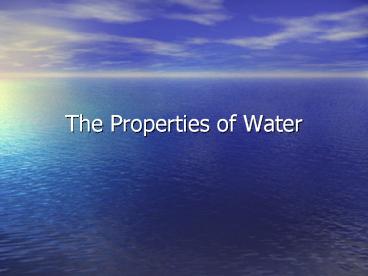The Properties of Water - PowerPoint PPT Presentation
1 / 19
Title:
The Properties of Water
Description:
The Properties of Water The Mickey Mouse Molecule! The Mickey Mouse Molecule! Hydrogen Hydrogen Oxygen Structure of a Water Molecule Water is polar. – PowerPoint PPT presentation
Number of Views:172
Avg rating:3.0/5.0
Title: The Properties of Water
1
The Properties of Water
2
The Mickey Mouse Molecule!
Hydrogen
Hydrogen
Oxygen
3
Structure of a Water Molecule
- Water is polar.
- A polar molecule is a molecule that has an
electrical charge. - Water is made of
- 2 Hydrogen Atoms and 1 Oxygen atom.
- The chemical formula for water is H2O
- Hydrogen has a positive () charge and Oxygen has
a negative (-) charge.
4
4 Key Properties of Water
- Capillary Action
- Surface Tension
- Universal Solvent
- Specific Heat
5
Capillary Action
- Capillary action is the combined force of
attraction among water molecules and with the
molecules of surrounding materials. - Examples of Capillary Action of Water
- Liquid rising inside a straw
- Paper towel absorbing water
- Wet jeans
- Plant roots absorbing water
- Sponge
6
Surface Tension
- Surface tension is the tightness across the
surface of water that is caused by the polar
molecules pulling on one another - Examples of the surface tension of water
- Raindrops forming beads on surface
- Water strider
- Paperclip Floating on Water
- Drops of Water on a Penny
- Skipping Rocks
- Meniscus
- Belly Flops
7
Jesus Lizard
8
(No Transcript)
9
Water Strider
10
Universal Solvent
- Solution A mixture that forms when one
substance dissolves another. - Solvent substance that does the dissolving.
- Solute substance that gets dissolved.
- Water is the universal solvent because it
dissolves so many substances because of its high
polarity. - Water can dissolve substances such as salt and
sugar but cannot dissolve oil. - - Polar Dissolves Polar.
11
(No Transcript)
12
Specific Heat
- Water requires a lot of heat (gain or loss) to
change its temperature due to the strong
attraction among water molecules. - Specific heat is the amount of heat needed to
increase the temperature of a substance by 10C - Example of specific heat
- - Water temperature vs. sand temperature at the
beach during the day.
13
Why does water have a high specific heat?
- Waters high specific heat is due to the strong
attraction among water molecules. - The molecules are stuck together and it takes a
lot of energy to break the strong bonds of the
water molecules.
14
Changing State
- Water exists in 3 forms
- solid
- liquid
- gas
solid
liquid
gas
15
Molecule Movement
- Molecules move the slowest in a solid.
- Solid-molecules are close together
- Molecules move the fastest in a gas.
- Gas-molecules move freely they are spread apart
16
Phase Changes
- Melting-water changes from a solid to a liquid
- Example Ice melts into water
- Freezing-water changes from a liquid to a solid
- Example Water freezes into ice
Melting
Solid
Liquid
Freezing
17
Phase Changes
- Evaporation- process by which molecules at the
surface of a liquid absorb enough energy to
change to the gaseous state - Example boiling water, hair air-drying, wet
clothes drying on a clothesline outside, puddle
drying up - Condensation-process by which a gas changes to a
liquid - Example water droplets on the outside of a
glass - fogging up a window
Evaporation
Gas
Liquid
Condensation
18
Phase Changes
19
Phase Change Diagram































